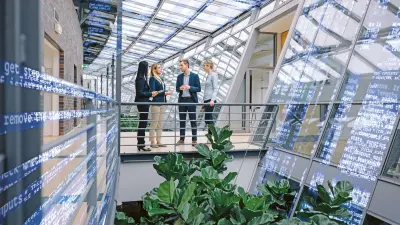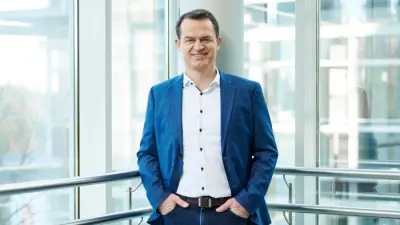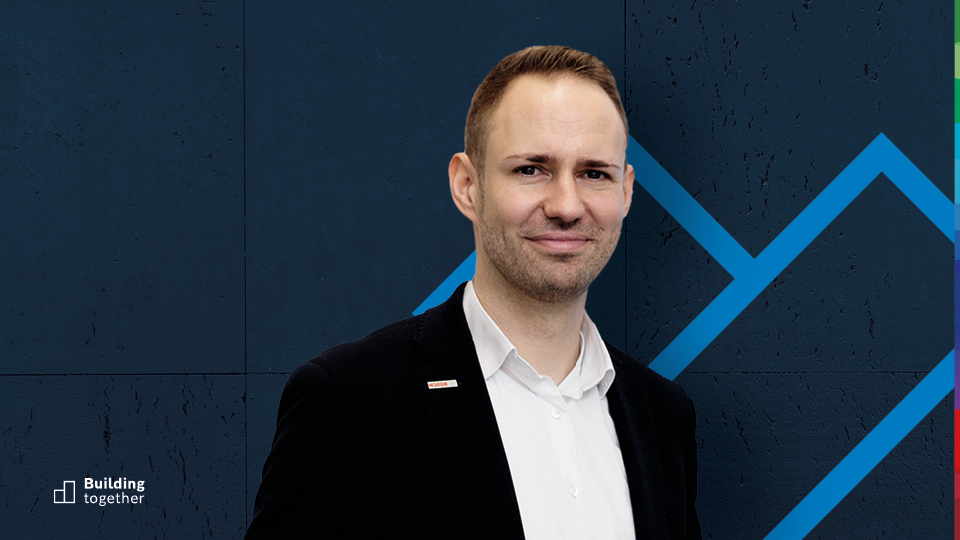When silent buildings learn to speak
The digital transformation is making rapid progress in many sectors and industries. What that means for commercial buildings, above all, is increased efficiency, comfort and quality based on artificial intelligence and IoT solutions. When it comes to new buildings, digitalization can be part of the thought process from the outset. But how do you make existing buildings smart – and what are the benefits for the users?

It’s Monday morning, and Ms. Müller is on her way into the company’s underground parking garage. Her ID is detected upon driving in and the gate opens automatically. Finding a parking space also goes smoothly: her app for employees shows Ms. Müller where there is a free space, and at which charging station she can ‘fill up’ her electric car later. When the project manager enters the office building, the elevator is already waiting for her and takes her to the right floor. Today, Ms. Müller is on her way to a meeting room she hasn’t been to before for a discussion with the team – thanks to the indoor navigation on her app, she quickly finds her way. When she finally opens the door to the room, the light and ventilation system switch on. The temperature is pleasant because the heating system knew how many people would meet here at what time, based on a reservation in the digital booking system. The entire building was working in a coordinated fashion and catering to its users in advance. Pretty accommodating, or in other words: pretty smart.
The example of Ms. Müller offers a glimpse of what commercial buildings could be capable of in the future – and in some cases, are already capable of doing. A building becomes a smart building when the individual components of the building technology are linked up to form a network. In essence, the building uses a shared ‘brain’, i.e. a central control unit in the form of artificial intelligence (AI). This allows the individual components to ‘talk’ to each other and exchange data between different parts of the system.

The ‘brain’ never stops learning
As all this is happening, the AI is constantly building up its knowledge. It learns from the data generated by operations, the users and the environment in order to formulate suggestions for improvements. This allows processes to be managed and optimized, thereby generating both economic and environmental added value for building operators. For example, the ‘brain’ identifies unused areas and switches off cooling, heating and lighting systems accordingly.
All relevant technical building processes can be monitored using a central management system. This includes energy management, building safety and fire alarm systems, as well as control and monitoring systems. Digital data capture as comprehensive as this greatly simplifies building operation, while also ensuring greater efficiency – which is of immense added value for the operators. Another advantage of smart buildings is that, by combining Internet of Things (IoT) technologies into an integrated software-based system, they will never actually become outdated. The sensors can be replaced at low cost, and the software can be updated as required, just like a PC or laptop.
“An upgrade is always better than a new building”
This is what fundamentally distinguishes a smart building from other commercial buildings that are equipped with self-contained building technology. In the latter case, the different systems run parallel to one another, instead of communicating with each other. However, intelligence and connectivity are by no means only suitable for new buildings – existing buildings can also join the digital age. After all, many older properties are already equipped with the cornerstone for it, with many technologies, systems and sensors already having been installed in them. “In the long term, this is about teaching the systems how to talk to each other,” says Klaus Dederichs, head of the Information and Communication Technology division at Drees & Sommer. For this to work, Drees & Sommer carries out a ‘digital ready check’ in advance and checks technical requirements such as IT infrastructures and connectivity. When talking about the digitalization of (existing) buildings, there’s an important technology that can’t be left out of the discussion: the ‘digital twin’. Historical data and real-time data capture are used to create a digital replica of a property – and one that is constantly evolving. This technology enables transparency and provides knowledge about the building as well as how it operates – an ideal basis for continuous optimizations.
Use of the digital building twin also makes another thing clear: “Each existing building is one of a kind with its own needs,” as Bent Mühlena, who is in charge of real estate project management at Union Investment Real Estate GmbH, says. According to Mühlena, however, one principle applies to all existing properties: “The longer a building exists and is in use, the more sustainable it is. An upgrade is therefore always better than a new building.”
Intelligently sustainable
Smart buildings that have been born out of existing buildings can also become role models in terms of sustainability. This is an area in which there is an urgent need for action. Buildings currently account for almost 40 per cent of global CO₂ emissions. Intelligent real estate can make a major contribution to reducing these emissions, as Bent Mühlena explains: “An intelligent energy management system, for example, allows emissions to be reduced by up to 30 per cent per building.” Systems like this calculate and analyze the energy consumption in the building. These analyses are used as a basis to identify potential savings and ensure energy efficiency gains over the long term – lower costs with no loss of performance. “Load peaks and incorrect settings can, for example, be identified, faults are detected at an early stage, and the entire energy infrastructure is optimized,” says Mühlena.

Tapping potential savings
Klaus Dederichs can offer an example: “Let’s take heating, cooling and ventilation for rooms such as offices – this is where some of the highest costs are generated.” Regulation does take a certain period of time to take effect, as it depends on various factors – for example, the outside temperature, the humidity or the wind conditions. In most buildings, a default time period that will definitely suffice can be assumed. As Dederichs point out, “A smart building, on the other hand, determines the optimal period of time and automatically regulates conditions in the rooms in response to actual requirements.”
Safe, comfortable, efficient
In addition to increased energy efficiency, smart buildings offer any number of other advantages and opportunities for owners, operators and users. Let’s take another look at the example with Ms. Müller: in her case, the building has, in the background, largely catered to her needs in terms of looking for a parking space, booking a room, switching on lighting and adapting the temperature – a significant contribution to the comfort, satisfaction and health of everyone in the building. This is revealed by the small details: if the coffee machine is broken, for example, it is easy to notify facility management using the app. More-over, indoor navigation guides visitors to the right place, innovative monitoring processes ensure greater security and, by using ‘predictive maintenance’ systems, maintenance work can be planned in advance – which includes the option of remote maintenance. The sky is the limit in this regard – the potential of systems like this is all but infinite. Dederichs is, however, keen to point out that new solutions need to focus on the benefits for people: “Smart buildings are never an end in themselves.” Yet they could play a more significant role in the battle to recruit younger employees in the future, as he says: “The expectations that digital natives have of their working environments keep getting higher.”

Cyber security strategies: staying on the safe side
Smart buildings such as the office building that Ms. Müller works at, along with others that have been equipped with smart technologies such as airports or shopping centers, have complex security requirements. An office building with thousands of networked sensors offers significantly more points of attack for cybercriminals than a ‘silent’ building does. Security requirements for software and hardware should therefore be factored in during the planning phase. But if you have the right cybersecurity strategy from the outset, you don’t have to worry too much, as Klaus Dederichs says. According to him, one of the measures required is penetration tests: “IT experts use hacker methods to test the vulnerability of the systems to external attacks.” In addition to firewalls, antivirus programs and regular updates, the smart building expert also recommends subdividing the IT system into network segments with clear access rights and round-the-clock security monitoring.
A new mentality for a smart future
Sustainable, comfortable, efficient: it’s no wonder that the market for smart buildings is growing rapidly and the demand for innovations is rising. And yet the trend has not yet arrived everywhere, notes Klaus Dederichs with dismay: “In some cases, people are still planning the same way they did 20 years ago – we really need to join building planners in creating a new mentality.” At the same time, Bent Mühlena reminds us not to get carried away. Every single time it’s important, he says, to re-examine which solutions really bring benefits for which type of building: “I recommend the ‘CS’ principle – common sense. This will also help you to find smart solutions that satisfy your own requirements.” And this is exactly what the topic of smart buildings is about, as both experts are unanimous: directing the focus at people and their needs.


